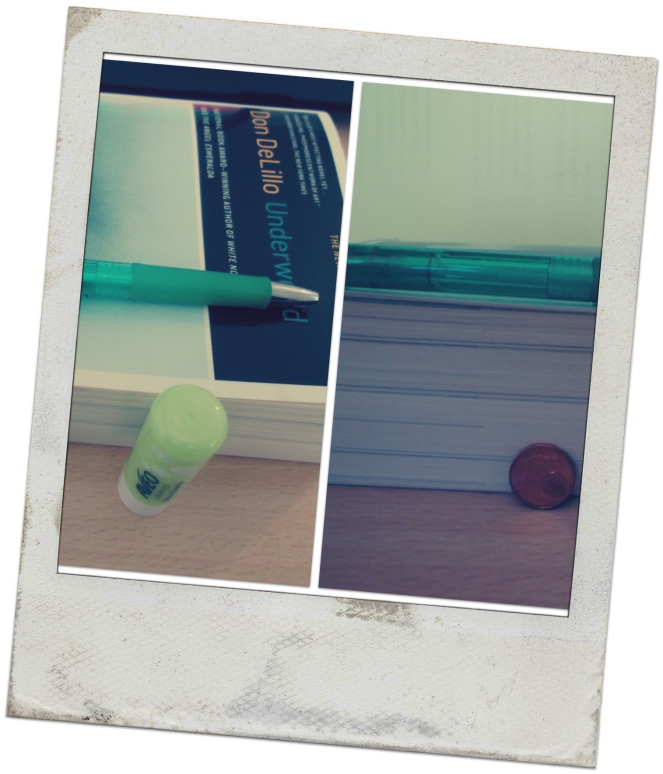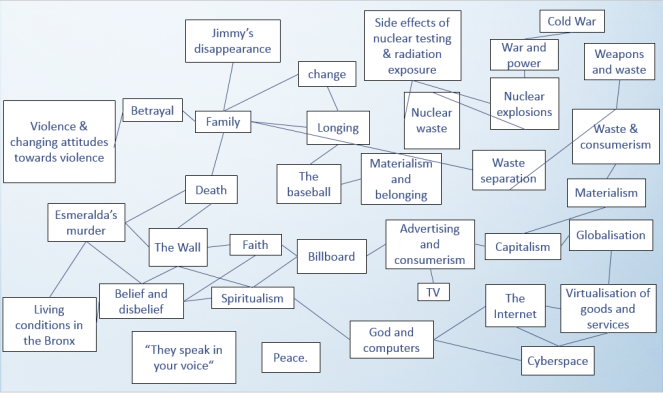Where do I even begin? My task for today: review the 827 page novel I had to read for class last semester. I’ll start by illustrating what 827 pages look like:

…can you tell that this book has a lot of pages? Did I make that clear? Ok, moving on. 🙂
I would start by giving you a brief overview of the plot, but that alone would probably fill three posts. The editors of the volume I picked up tried to do just that and the blurb reads as follows:
Nick Shay and Klara Sax knew each other intimately in New York when they were young, and they meet again decades later in the American desert. He is trying to outdistance the crucial events of his early life, haunted by a gunshot in a basement room. She is an artist who has made a blood struggle for independence.
Don DeLillo’s mesmerizing novel takes the reader deeply into the lives of Nick and Klara and into the soul of American culture – from Bronx tenements to grand ballrooms to a bombing raid over Vietnam. It is his greatest and most powerful work.
Unfortunately I have to say that this is probably one of the most misleading blurbs I ever read. I started reading the novel thinking that It would be about Nick and Klara, their lives, their history, their shared past. It is not. Well it is. But it’s certainly not the primary focus of the novel.
Instead of really focusing on a plot in the classical sense of the word, Underworld focuses on everything at once but nothing in particular. It is a very rich novel full of references to people and events from the last century. For example, we get to read about J. Edgar Hoover and Frank Sinatra at a baseball game in 1951, the Cuban Missile Crisis and the Texas Highway Killer.
It is a novel about the interconnectedness of things. About your neighbour knowing someone who knows someone who knows someone who knows your first grade teacher. It is a novel about the fact that there is never only just one side to a story, a coin, to anything.
 Many people say this novel is about a baseball. A baseball that gets caught at the game in 1951 and that travels from one person to another throughout the novel. I disagree. I don’t think the novel is about a baseball. The baseball is just a nice way to illustrate the way people’s lives touch even though they never get to meet or truly know each other – they are still connected through a baseball.
Many people say this novel is about a baseball. A baseball that gets caught at the game in 1951 and that travels from one person to another throughout the novel. I disagree. I don’t think the novel is about a baseball. The baseball is just a nice way to illustrate the way people’s lives touch even though they never get to meet or truly know each other – they are still connected through a baseball.
It’s a very poetic, very DeLillonian (shut up auto-correct, this is a word now) novel. I doubt anyone reads Don DeLillo’s novels because of their plots. It’s never about the plot. It’s about the little absurdities of life. Like the Hitler studies professor who can’t speak German and the most photographed barn in the world (both examples are taken from White Noise, in case you’re wondering).
In Underworld it is the way DeLillo manages to say so much while baring so little (I see this concept reflected in my post right now and I promise to stop in a bit!). It’s the way we learn that  Nick’s father abandoned the family, that he went out to buy cigarettes and never returned. We’re told about this and then the narrator (Nick) goes on musing about Lucky Strikes and how the package design always reminds him of a target because – what else would it be? His musings go on for so long that one almost forgets what the point of the paragraph was, namely the disappearance of Nick’s father.
Nick’s father abandoned the family, that he went out to buy cigarettes and never returned. We’re told about this and then the narrator (Nick) goes on musing about Lucky Strikes and how the package design always reminds him of a target because – what else would it be? His musings go on for so long that one almost forgets what the point of the paragraph was, namely the disappearance of Nick’s father.
Another striking feature of the novel – even though it makes it difficult to follow the plot – is the way it is told. It is divided into 6 six parts, a prologue and an epilogue. The prologue tells the story of the baseball game in 1951 and the epilogue sums up what happens to the characters as the new millennium approaches. So far, so logical. It’s the parts in between that are truly interesting:
- Part 1: spring – summer 1992
- Part 2: mid-1980s – early 1990s
- Part 3: spring 1978
- Part 4: summer 1974
- Part 5: selected fragments public and private in the 1950s and 1960s
- Part 6: fall 1951 – summer 1952
The narration goes backwards in time. For example, there’s one segment in which Klara complains about her ex-husband and it is followed by one in which she is still madly in love with him. While it is intriguing to follow the story from the present into the past, it also makes it nearly impossible for the reading experience to be plot driven. Usually we continue reading because we want to find out what happens next. Underworld does not grant us this satisfaction. One could argue that all along we want to figure out what Nick did to be put into juvenile detention, but it didn’t seem to me like that was the point, although I must say that the scene that describes what he did to deserve that was actually quite shocking. O.o
I did a presentation on the epilogue of the novel and was also entrusted with the task of ‘briefly’ summing up the themes mentioned in the novel (I had 10 minutes in total, so not very much time at all!). It was basically impossible but I’ll leave you with the result of my efforts to summarise the themes of the novel. Maybe you’ll forgive me for the lack of structure in this post after you saw what I was dealing with here. 😉
Did you read Underworld / any other novels by Don DeLillo?
If you did – which where the outstanding themes in your opinion? What do you think about the blurb I quoted above? Misleading? Accurate?


OH my, what a book!
LikeLike
What a book indeed! I’m still avoiding the idea of writing a term paper about it!
LikeLike